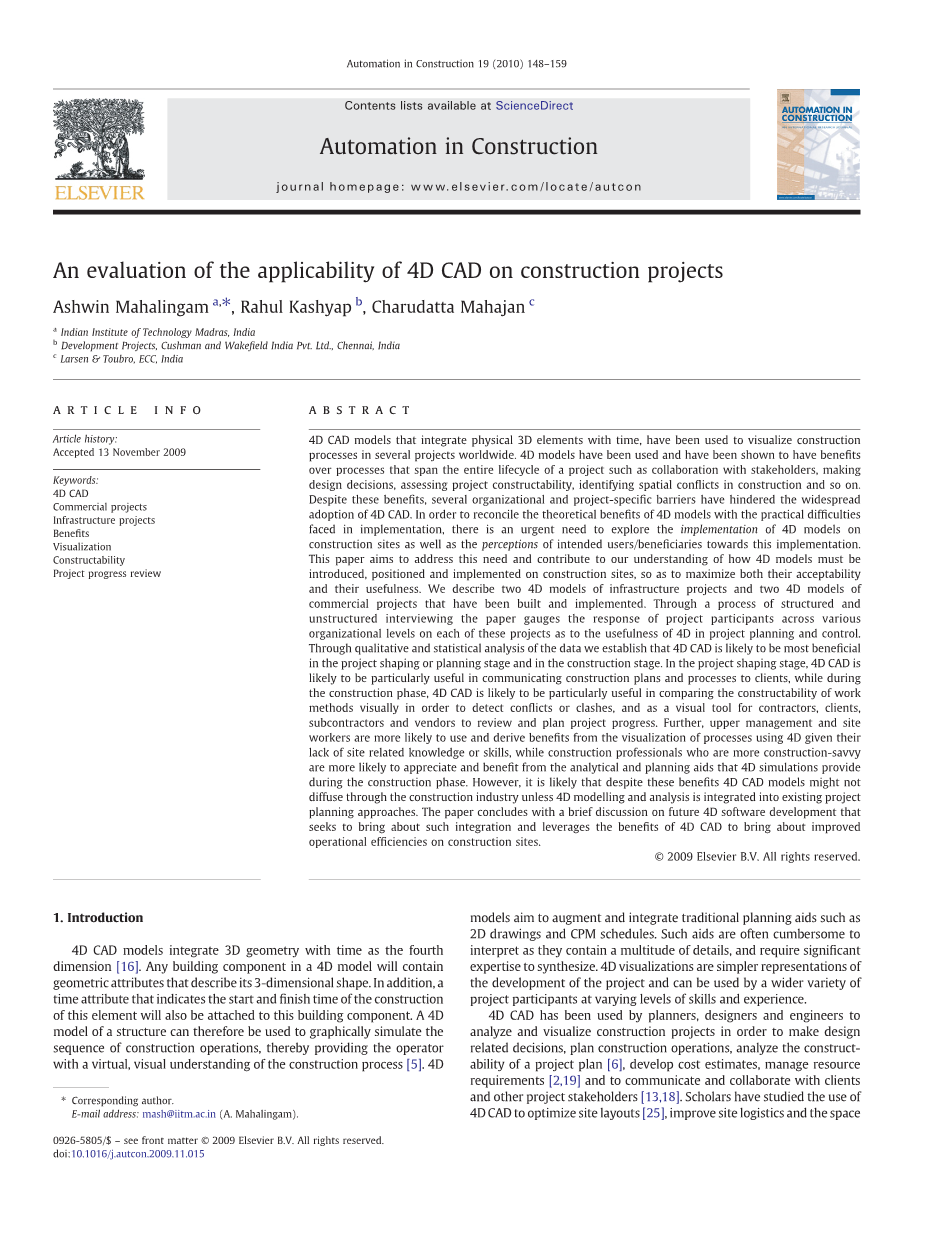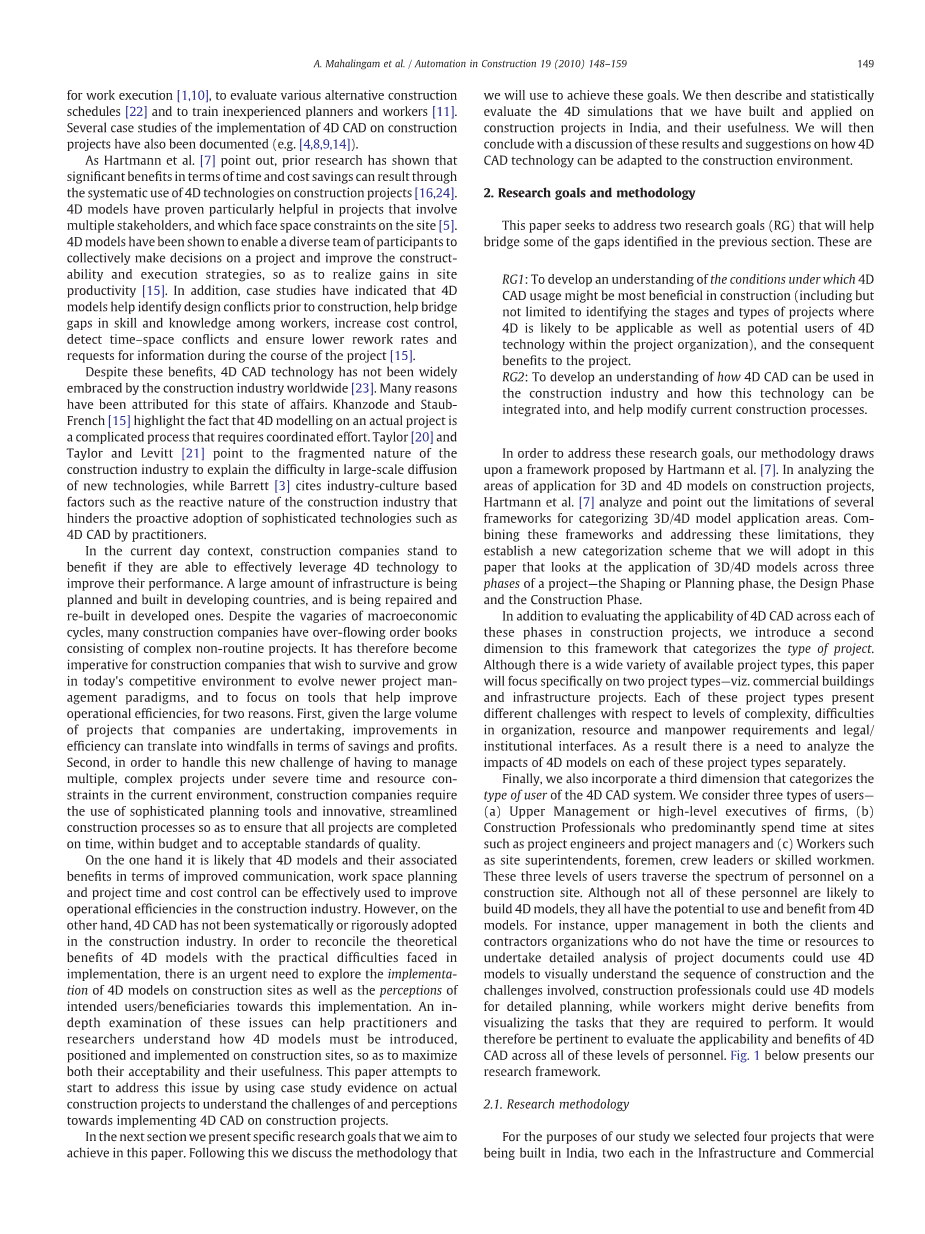

英语原文共 12 页,剩余内容已隐藏,支付完成后下载完整资料
An evaluation of the applicability of 4D CAD on construction projects
4D CAD施工项目的适用性评价
Ashwin Mahalingam a,* , Rahul Kashyap b, Charudatta Mahajan c
a Indian Institute of Technology Madras, India
b Development Projects, Cushman and Wakefield India Pvt. Ltd., Chennai, India
c Larsen amp; Toubro, ECC, India
ARTICLE INFO
文章信息
Article history:Accepted 13 November 2009
文章史:2009年11月13日被接受
Keywords:4D CAD,Commercial project,Infrastructure projects,Benefits,Visualization,Construct ability,Project progress review
关键词:4D CAD、商业项目、基础设施项目、利益、可视化、构建能力、项目进展
ABSTRACT
摘要
4D CAD models that integrate physical 3D elements with time, have been used to visualize construction processes in several projects worldwide. 4D models have been used and have been shown to have benefits over processes that span the entire life-cycle of a project such as collaboration with stakeholders, making design decisions, assessing project construct ability, identifying spatial conflicts in construction and so on. Despite these benefits, several organizational and project-specific barriers have hindered the widespread adoption of 4D CAD. there is an urgent need to In order to reconcile the theoretical benefits of 4D models with the practical difficulties faced in implementation, explore the implementation of 4D models on construction sites as well as the perceptions of intended users/beneficiaries towards this implementation. This paper aims to address this need and contribute to our understanding of how 4D models must be introduced, positioned and implemented on construction sites, so as to maximize both their acceptability and their usefulness. We describe two 4D models of infrastructure projects and two 4D models of commercial projects that have been built and implemented. Through a process of structured and unstructured interviewing the paper gauges the response of project participants across various organizational levels on each of these projects as to the usefulness of 4D in project planning and control. Through qualitative and statistical analysis of the data we establish that 4D CAD is likely to be most beneficial in the project shaping or planning stage and in the construction stage. In the project shaping stage, 4D CAD is likely to be particularly useful in communicating construction plans and processes to clients, while during the construction phase, 4D CAD is likely to be particularly useful in comparing the construct ability of work methods visually in order to detect conflicts or clashes, and as a visual tool for contractors, clients, subcontractors and vendors to review and plan project progress. Further, upper management and site workers are more likely to use and derive benefits from the visualization of processes using 4D given their lack of site related knowledge or skills, while construction professionals who are more construction-savvy are more likely to appreciate and benefit from the analytic and planning aids that 4D simulations provide during the construction phase. However, it is likely that despite these benefits 4D CAD models might not diffuse through the construction industry unless 4D modeling and analysis is integrated into existing project planning approaches. The paper concludes with a brief discussion on future 4D software development that seeks to bring about such integration and leverages the benefits of 4D CAD to bring about improved operational efficiency on construction sites.
4D CAD模型整合时间物理3D元素,已被用于全球多个项目施工过程的可视化。4D模型已被使用并且被证明是具有跨越的一个项目,如合作与利益相关者的整个生命周期过程的效益,设计决策,评估亲工程施工,确定施工空间冲突等。尽管有这些好处,一些组织和项目具体障碍依旧阻碍了4D CAD技术的广泛应用。为了调和4D理论价值和模型实施中面临的实际困难,我们迫切需要探索实施4D模型构建网站以及预期的用户/受益者对其看法。本文旨在解决这方面的需要,帮助我们了解4D模型如何必须被引入,定位和施工现场的实施,以最大限度地提高双方的可接受性和实用性。我们描述了已建立和实施的两个四维模型的基础设施项目和两个4D模型的商业项目。通过一个结构化和非结构化面试的过程,本文测量在不同的项目组织水平中项目参与者对4D项目计划和控制实用性的响应。通过我们建立的对数据的定性和统计分析4D CAD可能在项目规划阶段和成型或在施工阶段最有益。在项目形成阶段,4D CAD可能在与客户沟通施工计划和流程方面特别有用,而在施工阶段,4D CAD可能更加有益于直观地比较工作方法以检测冲突或矛盾,并且作为承包商、客户、分包商和供应商的可视化工具以审查和计划项目进展。此外,高层管理人员和现场工人是更有可能使用并且从使用4D获取他们所缺乏的知识或技能的可视化过程中获益的,而那些更精明的建筑专业人士更有可能欣赏和从4D模拟在施工阶段提供的分析和规划辅助中获益。但是,除非4D建模与分析集成到现有的项目规划方法中去,否则尽管有这些好处4D CAD模型通过建筑业也可能无法扩散。本文最后简要讨论未来4D软件开发,旨在实现这样的整合并利用4D CAD的优势以提高施工现场作业效率。
copy; 2009 Elsevier B.V. All rights reserved.
copy;2009 Elsevier B.V.保留所有权利。
1. Introduction
1、引言
4D CAD models integrate 3D geometry with time as the fourth dimension [16]. Any building component in a 4D model will contain geometric attributes that describe its 3-dimensional shape. In addition, a time attribute that indicates the start and finish time of the construction of this element will also be attached to this building component. A 4D model of a structure can therefore be used to graphically simulate the sequence of construction operations, thereby providing the operator with a virtual, visual understanding of the construction process [5]. 4D models aim to augment and integrate traditional planning aids such as 2D drawings and CPM schedules. Such aids are often cumbersome to interpret as they contain a multitude of details, and require significant expertise to synthesize. 4D visualizations are simpler representations of the development of the project and can be used by a wider variety of project participants at varying levels of skills and experience.4D CAD has been used by planners, designers and engineers to analyze and visualize construction projects in order to make design related decisions, plan construction operations, analyze the construct-ability of a project plan [6], develop cost estimates, manage resource requirements [2,19] and to communicate and collaborate with clients and other project stakeholders [13,18]. Scholars have studied the use of 4D CAD to optimize site layouts [2
剩余内容已隐藏,支付完成后下载完整资料
资料编号:[146038],资料为PDF文档或Word文档,PDF文档可免费转换为Word
您可能感兴趣的文章
- 饮用水微生物群:一个全面的时空研究,以监测巴黎供水系统的水质外文翻译资料
- 步进电机控制和摩擦模型对复杂机械系统精确定位的影响外文翻译资料
- 具有温湿度控制的开式阴极PEM燃料电池性能的提升外文翻译资料
- 警报定时系统对驾驶员行为的影响:调查驾驶员信任的差异以及根据警报定时对警报的响应外文翻译资料
- 门禁系统的零知识认证解决方案外文翻译资料
- 车辆废气及室外环境中悬浮微粒中有机磷的含量—-个案研究外文翻译资料
- ZigBee协议对城市风力涡轮机的无线监控: 支持应用软件和传感器模块外文翻译资料
- ZigBee系统在医疗保健中提供位置信息和传感器数据传输的方案外文翻译资料
- 基于PLC的模糊控制器在污水处理系统中的应用外文翻译资料
- 光伏并联最大功率点跟踪系统独立应用程序外文翻译资料



